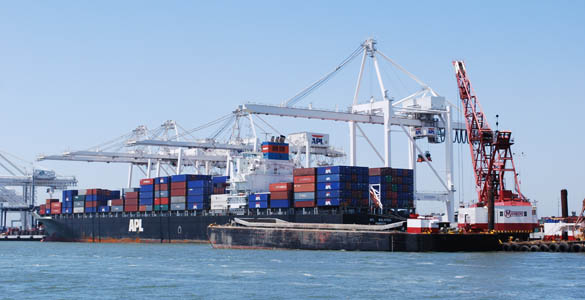The U.S. Department of Commerce recently approved the Port of San Francisco’s request to reorganize its Foreign Trade Zone (FTZ) #3 under the new Alternative Site Framework (ASF) program.

Ten container terminals and two intermodal rail facilities serve the Oakland waterfront. Oakland’s cargo volume makes it the fourth busiest container port in the United States. Photo by Joel Williams
By Patrick Burnson
Published: April, 2012
The U.S. Department of Commerce recently approved the Port of San Francisco’s request to reorganize its Foreign Trade Zone (FTZ) #3 under the new Alternative Site Framework (ASF) program.
According to Port spokesmen, the new process requires less paperwork and streamlines the procedure for businesses to apply for a zone. The new ASF program allows existing companies and new companies in San Francisco and San Mateo counties to secure FTZ status within approximately 30 days from when an application is accepted. Without the program, the process can take 8-12 months.
A Foreign Trade Zone is a secured area in a designated customs "port of entry," and while physically located within the United States, it is considered outside U.S. Customs territory. This allows for foreign goods to be brought into FTZs without formal customs entry for manufacturing, testing, assembly, processing, storage, and distribution. Duty payments on imported goods and materials can be reduced or eliminated, or deferred until they leave the designated area and enter U.S. commerce. Goods not entering U.S. commerce, for instance re-exports, are not obligated to pay customs duties.
The Alternative Site Framework program expands upon the benefits already granted within the FTZ program in an efficient way. Companies have the advantage to extend the FTZ benefits to their own already-existing manufacturing, processing and distribution locations within San Francisco and San Mateo counties, yet outside of the Port of San Francisco.
"The new expedient process gives San Francisco and San Mateo companies a competitive advantage, especially when competing on a global scale," said Peter Dailey, maritime director for the Port of San Francisco. "Foreign Trade Zones are one tool to reduce logistics costs, which translates into savings to a company’s bottom line. More competitive companies translate into new economic opportunities and help create new jobs."
While San Francisco’s waterfront cargo operations are dwarfed by neighboring Oakland, it remains a viable "niche" gateway. Late last year, Secretary of Transportation Ray LaHood announced that the Port of San Francisco would be awarded nearly $3 million for rail improvements aimed at improving segments of its freight rail track in order to enhance safety, livability and economic development.
Port of Oakland Hosts China Symposium
The Port of Oakland and China Merchants Holdings International (CMHI) hosted a "China Briefing and Roundtable Discussion" as a continuation of the port’s annual China symposium to raise awareness around U.S.-China trade issues and provide an opportunity for CMHI and other business partners to grow export-import trade opportunities.
The discussion covered: challenges for U.S. companies when they trade with China; China’s shipping and logistics landscape; maritime and intermodal infrastructure and its impacts on sourcing and manufacturing in China; and cold chain development in the Chinese hinterland. Noted U.S. trade economist Dan Smith, principal of the Tioga Group, a freight transportation consulting service, also provided a forecast of 2012-2013 trade growth, based on consumer demand cycles in China and the United States, global currency valuations, and the shift in China’s demographic profile.
This program is one of several initiatives launched jointly by the Port of Oakland and CMHI as a result of a memorandum of understanding signed in November 2010. The memorandum represents a strategic partnership for marketing cooperation to promote trade between the U.S. and China and to extend supply chain services for U.S. exporters throughout China, with a focus on U.S. agricultural and perishable food exports from Oakland to China’s coastal and inland population centers.
Environmental Topics Dominate Warehouse Logistics Expo
"Going Green" is no longer a choice for supply chain managers – it’s a given. Shareholder pressure is forcing publicly-held manufacturers to adhere to the highest levels of sustainability, said industry analysts and experts speaking last month at the International Warehouse Logistics Association 2012 Convention & Expo in San Francisco.
"As logistics providers we can’t afford to wait for the government or its regulators to tell us how to be responsible corporate citizens," said IWLA President and CEO Joel Anderson. "Fortunately, we have not been standing still on this issue."
That point was reinforced by a panel of shippers, consultants, and academic leaders who addressed the association’s "sustainable logistics initiative."
"This is not about ‘tree-hugging,’" said Bruce Carlton, president and CEO of the National Industrial Transportation League. "When the league was asked to partner in this initiative, we recognized that this represents a unique metric-driven breakthrough. It’s an ideal public/private solution to ongoing supply chain concerns."

